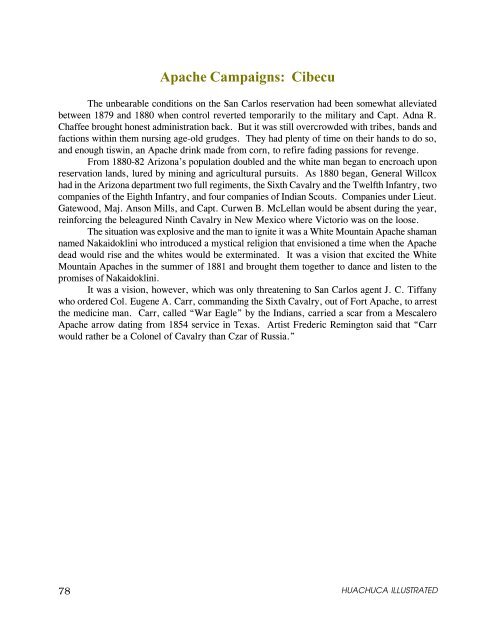Apache Campaigns - Fort Huachuca - U.S. Army
Apache Campaigns - Fort Huachuca - U.S. Army
Apache Campaigns - Fort Huachuca - U.S. Army
You also want an ePaper? Increase the reach of your titles
YUMPU automatically turns print PDFs into web optimized ePapers that Google loves.
78<br />
<strong>Apache</strong> <strong>Campaigns</strong>: Cibecu<br />
The unbearable conditions on the San Carlos reservation had been somewhat alleviated<br />
between 1879 and 1880 when control reverted temporarily to the military and Capt. Adna R.<br />
Chaffee brought honest administration back. But it was still overcrowded with tribes, bands and<br />
factions within them nursing age-old grudges. They had plenty of time on their hands to do so,<br />
and enough tiswin, an <strong>Apache</strong> drink made from corn, to refire fading passions for revenge.<br />
From 1880-82 Arizona’s population doubled and the white man began to encroach upon<br />
reservation lands, lured by mining and agricultural pursuits. As 1880 began, General Willcox<br />
had in the Arizona department two full regiments, the Sixth Cavalry and the Twelfth Infantry, two<br />
companies of the Eighth Infantry, and four companies of Indian Scouts. Companies under Lieut.<br />
Gatewood, Maj. Anson Mills, and Capt. Curwen B. McLellan would be absent during the year,<br />
reinforcing the beleagured Ninth Cavalry in New Mexico where Victorio was on the loose.<br />
The situation was explosive and the man to ignite it was a White Mountain <strong>Apache</strong> shaman<br />
named Nakaidoklini who introduced a mystical religion that envisioned a time when the <strong>Apache</strong><br />
dead would rise and the whites would be exterminated. It was a vision that excited the White<br />
Mountain <strong>Apache</strong>s in the summer of 1881 and brought them together to dance and listen to the<br />
promises of Nakaidoklini.<br />
It was a vision, however, which was only threatening to San Carlos agent J. C. Tiffany<br />
who ordered Col. Eugene A. Carr, commanding the Sixth Cavalry, out of <strong>Fort</strong> <strong>Apache</strong>, to arrest<br />
the medicine man. Carr, called “War Eagle” by the Indians, carried a scar from a Mescalero<br />
<strong>Apache</strong> arrow dating from 1854 service in Texas. Artist Frederic Remington said that “Carr<br />
would rather be a Colonel of Cavalry than Czar of Russia.”<br />
HUACHUCA ILLUSTRATED

















